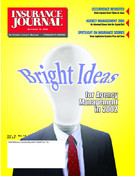The agency system is positioned to make significant progress with technology and business process improvement over the next three years, but progress will not happen on its own. It will be realized only through the active involvement of agency principals and the continued efforts of a number of leaders who are supporting the adoption of standards and industry-based solutions. I’m excited about this prospect because it will give our distribution system a sustained competitive advantage for years.
Branding research shows that consumers appreciate the agency business model more than ever because of the independence, advocacy, multiple-company representation and local presence that independent agents offer. However, direct and captive-agent companies will continue to seek to exploit their use of technology and simpler business model to gain advantage over independent agents.
The good news is that available technology permits independent agents to “trump” these competitors’ efforts by providing similar efficiencies and adding unique advantages to independent agents.
I’m optimistic that the agency system will “jump” at this opportunity to use technology strategically. There are more industry players focused today on how our distribution system can use new technology to improve agency business operations than there have been over the past 25 years. These experts represent companies, vendors, user groups, agent associations and industry organizations. Several new vendors seek to serve agents with new types of agency management systems, provide agents 24/7 capability or enhanced sales and marketing capability. Organizations have been formed such as the Agents Council for Technology (ACT—affiliated with IIABA) and AUGIE (representing user groups—affiliated with ACORD) to bring stakeholders together to discuss issues and to keep the focus.
New ACORD XML standards hold great promise because they are more flexible than past standards and allow agent, company and other business partner systems to communicate in real-time. There is a lot of excitement about the potential for XML standards to solve a number of the problems that have stymied true single-entry, multiple-company interface solutions. Now it is time for companies, vendors and agents to push for and make investments to implement these standards and to get started with real-time processing. I believe it increasingly will become clear that winning companies and vendors will be those incorporating the XML standards and resulting open architecture that facilitates communication with outside systems.
The results of the latest Best Practices Study show that technology and business-process improvements have become more important as factors to enhance the bottom-line of Best Practices agencies. And some of the most innovative firms are smaller agencies. In fact, Best Practices agencies with revenues between $500,000 and $1,250,000 showed the greatest improvement in their bottom-line. Best Practices agencies focus consistently on improving workflow processes, using the latest software versions, integrating technology with workflows, training staff in these areas, and requiring staff to follow procedures and use the computer as the primary information source.
Effective execution of sound strategies, workflows and technologies will distinguish winning agencies, companies, and vendors over the next decade. In the same way, the industry overall needs to focus on execution, including implementation of the ACORD XML standards, industry solutions that feature open architecture, and tools to help agencies implement new business processes and technologies effectively. Look for ACT, AUGIE, ACORD, the user groups, and dedicated industry leaders to keep the focus on these critical issues, reasoned dialogue, and making continuing improvements. These organizations and individuals, however, will need the active support of agency principals to champion improvements with company and vendor CEOs.
By 2005, we will see extensive use of ACORD XML standards. We will make substantial progress toward achieving SEMCI solutions. Company Web sites will be much more intuitive for agents; agency systems will be able to logon automatically to the appropriate page of the company site; and data in the agency system will pre-fill the company screens. We also will see more agencies planning and budgeting for improvements in their business processes and technology. There will be considerably more use of technology to enhance sales, sales management and personalized customer service.
As a result of this focus on execution, the agency system will be in the strongest competitive position that it has been in since the emergence of competing distribution systems in the first half of the 20th century.
Jeff Yates is executive director of the Agents Council for Technology which is affiliated with the Independent Insurance Agents and Brokers of America Inc. During a 25 year tenure with the IIABA, Yates served in various capacities, including general counsel, executive vice president, and CEO Industry and State Relations. Contact him at jeff.yates@iiaba.net or visit the ACT Web site at www.independentagent.com. This article reflects the opinions of the
author and should not be construed as an official statement of ACT.
Was this article valuable?
Here are more articles you may enjoy.


 Big ‘I’ Report: Independent Agency Channel Placed 62% of Premiums in 2023
Big ‘I’ Report: Independent Agency Channel Placed 62% of Premiums in 2023  A $29 Billion Weed Market Fights to Diversify Amid Legal Hurdles
A $29 Billion Weed Market Fights to Diversify Amid Legal Hurdles  US Judge Skeptical of Biden Overtime Pay Rule
US Judge Skeptical of Biden Overtime Pay Rule  GEICO Tops Progressive With Higher J.D. Power Scores
GEICO Tops Progressive With Higher J.D. Power Scores 


